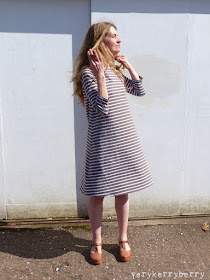Three months into Sarah Fielke's Simple Folk block of the month and I'm keeping up. Each month seems to have a different challenge- be it a different aspect of appliqué or working out the spacer blocks that go in between, there's always something new to learn or a skill to improve. The instructions are generally very detailed and the videos are a supportive visual security blanket, but I do have moments of uncertainty. With this block, I got a bit doubtful about how much to cut away on the reverse. There is a porthole style element in the centre of the star shape so that was all explained and worked well but general cutting away for applique, that's not been covered so far.
For the rest of the block, I followed my instincts and trimmed the larger layers back to a 1/4" seam allowance to reduce bulk. I'm going to take a look at my finished blocks and do the same, they do feel rather thick untrimmed!
As always, fabric choice takes time on these blocks. I'm aware that there's lots of yellow from the corner triangles and in the spacer blocks (see below). I'm also allowing for the scrappy pink fabrics in the mini 9-patch squares so it's a balancing act. I haven't bought the acrylic template sets that Sarah sells for this BOM- they would make the process a lot easier, especially cutting, but the cost with overseas postage is against me at the moment, so I used template plastic and made sure I cut accurately and transferred all the seam points so I can pencil them on the fabric pieces- essential for aligning those tricky shapes and with patient construction the block came together well. I made a test block out of scraps before committing to the good stuff and that was definitely worth doing!
Here's a little layout of what will be the top left corner of this quilt. The cobalt blue will be bordering these blocks, framing the grey backgrounds and as a canvas for lots of animal-themed appliqué around the edges. I am enjoying seeing the variety of blocks from BOM participants all over the world. Observing the choices and dilemmas of so many other quilters, all working on the same pattern in such a variety of fabrics is fascinating!






























